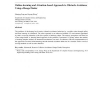Free Online Productivity Tools
i2Speak
i2Symbol
i2OCR
iTex2Img
iWeb2Print
iWeb2Shot
i2Type
iPdf2Split
iPdf2Merge
i2Bopomofo
i2Arabic
i2Style
i2Image
i2PDF
iLatex2Rtf
Sci2ools
JIRS
2007
2007
Online-learning and Attention-based Approach to Obstacle Avoidance Using a Range Finder
The problem of developing local reactive obstacle-avoidance behaviors by a mobile robot through online real-time learning is considered. The robot operated in an unknown bounded 2-D environment populated by static or moving obstacles (with slow speeds) of arbitrary shape. The sensory perception was based on a laser range finder. A learning-based approach to the problem is presented. To greatly reduce the number of training samples needed, an attentional mechanism was used. An efficient, real-time implementation of the approach was tested, demonstrating smooth obstacle-avoidance behaviors in a corridor with a crowd of moving students as well as static obstacles. Key words: Humanoid, Reactive Collision Avoidance, Range Finder, Perception Please send correspondence to Dr. Juyang Weng at the Department of Computer Science and Engineering, 3115 Engineering Building, East Lansing, MI 48824-1126, USA
JIRS 2007 | Obstacle-avoidance Behaviors | Reactive Obstacle-avoidance Behaviors | Smooth Obstacle-avoidance Behaviors |
| Added | 15 Dec 2010 |
| Updated | 15 Dec 2010 |
| Type | Journal |
| Year | 2007 |
| Where | JIRS |
| Authors | Shuqing Zeng, Juyang Weng |
Comments (0)

